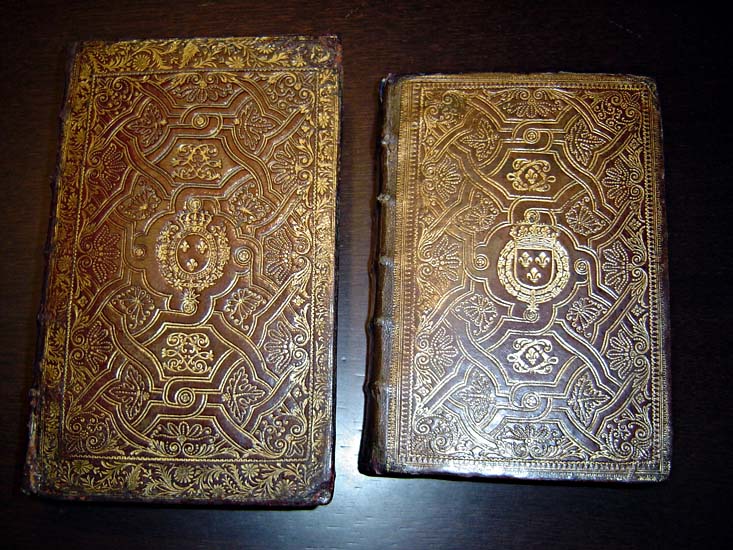

| When I first saw this photo from Hugues Ouvrard, I was baffled by the unusual pointillé tooling. I have never seen anything quite like it. Not to mention the strange dentelle arrangements. At first I thought that these bindings were not likely to be French. I had no idea where to start my research and requested some enlarged scans, noting a rather familiar looking roll (roulette) on the smaller of the two. This smaller binding encloses a 1715 Dezallier edition of the OFFICE DE LA SEMAINE SAINTE |
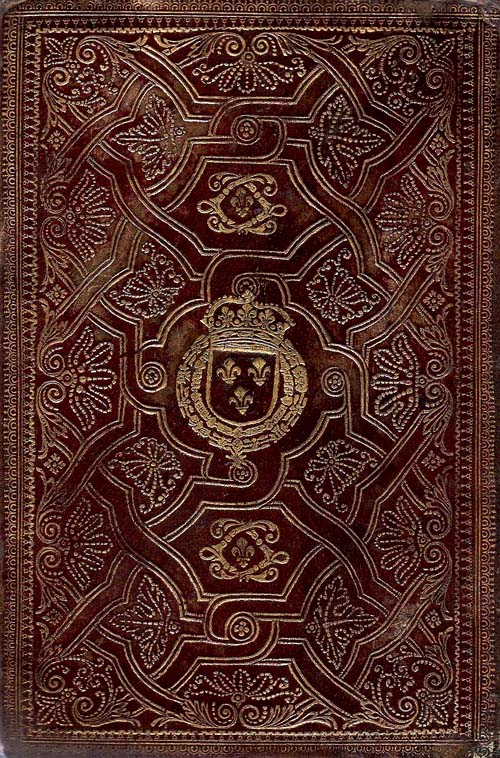
| Unfortunately the scans were not of a sufficient resolution to identify with certainty the roll in question. Coincidentally a similar roll was identified on another 1715 Dezallier, OFFICE DE LA SEMAINE SAINTE, and high resolution images revealed that this same roll had been used by Boyet (see the comparative diagram below). |
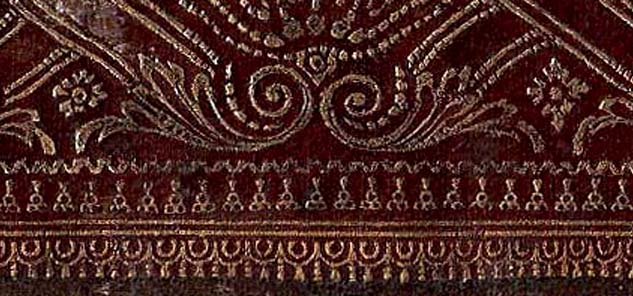
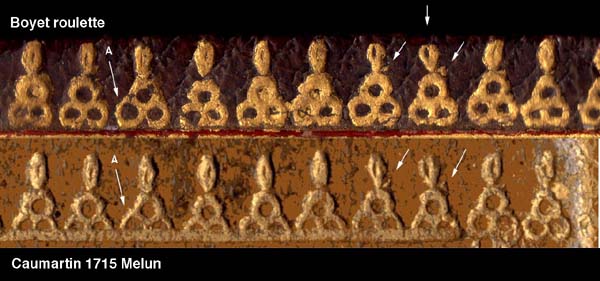
| I was at this point in time researching Brokatpapier, and was much distracted by the beautiful brokatpapier endpapers in this binding. An expert might be able to identify the maker and date of production of these specialized decorative foil papers which were imported into France from Germany. The production of these papers starts in the last quarter of the 17th century and becomes very popular in luxury bindings of the 18th century and beyond. |
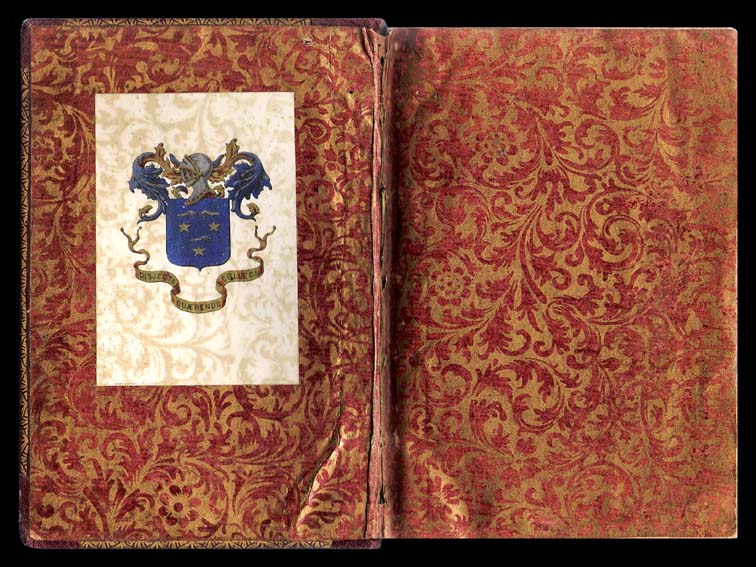
|
I have included here a full sized reproduction of this Brokatpapier. (at a screen setting of 600x800 dpi, the actual binding is 19.7 cm in height) and a link to an enlargement for anyone who wishes to research this. The importance of course is in pinning down a date of production, which would then give at least an earliest possible date of production for this binding. (please mail me immediately if you have any information that might be of help here).
It was about one month later that I discovered another very similar binding, a 1743 Collombat edition of the OFFICE DE LA SEMAINE SAINTE. It is shown below with the booksellers description |
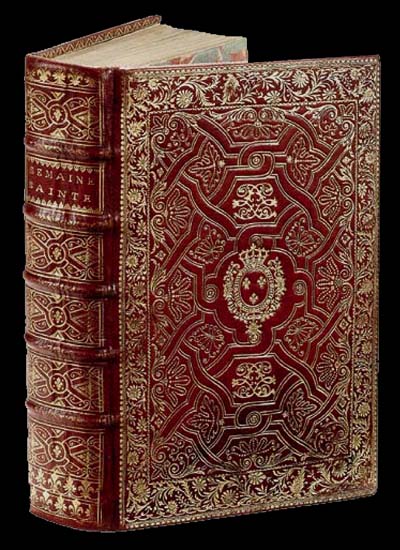
|
Bibliographic Details Publisher: Paris, L'Imprimerie De Jacques Collombat Publication Date: 1743 Description: Grand in-8 (220 x 150 mm). Contemporary red morocco, covers gilt tooled at top and bottom with 19 mm wide dentelle and at left and right with 13 mm wide dentelle. The area inside the dentelle is gilt tooled with interlacing quadruple filet, and inside the filet are leaves, sprays and flowers "en pointelle". The arms of Louis XV (1710-1774) are gilt embossed in the center of the covers, with his chiffre above and below the arms. Raised bands on spines with a small fleur-de-lis in the center of each compartment, surrounded by a circle and flanked by single and double filet in diamond and circular designs. Each compartment is bordered by double filet. Alternating fleur-de-lis are gilt tooled in one row at the top of spine and in two rows at the bottom of spine. Cover edges and turn-ins are gilt tooled, marbled endpapers, gilt page edges. Two frontispiece, one representing the King and Queen in prayer, and a title frontispiece. Five engravings in taille-douce (all without text) by Humblot, one at the beginning of each office. Printed on luxury Holland paper. Some minor rubbing to covers and spine. This volume was published by the Premier Imprimeur Order du Roy et de la Maison, by express command of His Majesty, conforming to the Breviaires and Missels Roman and Parisian, with the ceremonies of the church. References: Olivier 2495-9 and 2495-31. |
| This binding seemed to be identical to Hugues large binding so I emailed him for more details and sure enough his was another Collombat OFFICE DE LA SEMAINE SAINTE however a 1748 edition. Further researching Collombat editions turned up a identical binding, this time in a Collombat 1732 edition. Again it is shown below with the booksellers description, (note the mention of the armes of Louis XV, with a publishing date of 1732 one would expect to see the arms of Louis XV, however on closer inspection these armes prove to be those of Louis XIV, (see the Comparative Diagram at the bottom of this page). |
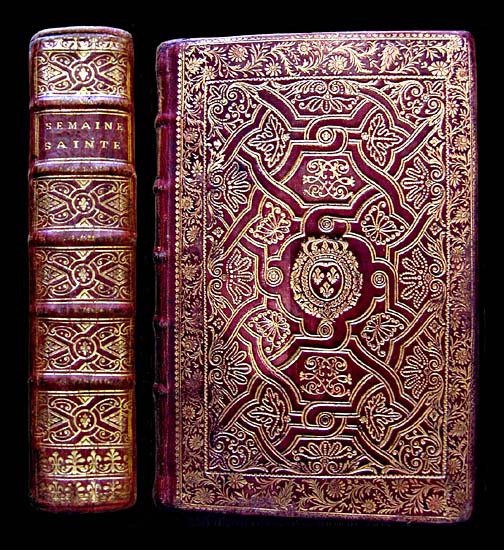
|
Office de la semaine-Sainte à l'usage de Rome et de Paris en latin et en françois avec l'explication des cérémonies de l'église (...) par Monsieur l'abbé de Bellegarde. Paris, Jacques COLLOMBAT, 1732. In 8 de 4 ff. n.ch., dont un front. et un titre gravés, XX-654 pp., 1 f. de privilège et LX pp., 4 fig. h.-t. d'après Humblot, gravés par Scottin, rel. d'ép. plein maroquin rouge richement orné d'entrelacs de quadruples filets dorés à compartiments orné 1 700,00 Euros Agréable exemplaire aux armes de Louis XV. |
| Then by a strange round about route I stumbled upon yet another example while searching for something else in the vastness of the British Library Database of Bookbindings. |
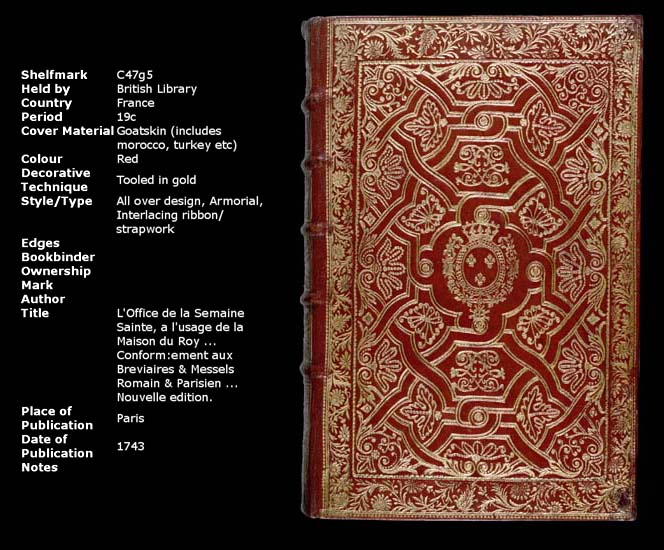
| After seeing so many identical bindings one suspects that these are not your normal gold tooled bindings. Fanfare strapwork is normally never perfect, even in the work of some of the greatest masters of the art we can still spot small overlaps or gaps. |
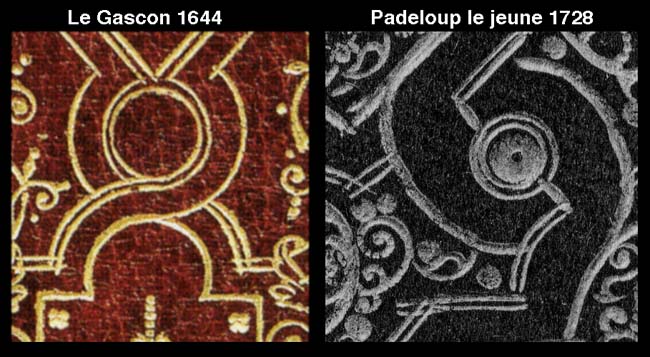
| A close inspection of the strapwork detail in these identical 18c bindings reveals a surprising accuracy, that is repeated in every binding. Obviously these bindings have not been hand tooled. |

| Not long after bookbinders had started laboriously decorating their bindings with heated tools to leave dozens or hundreds of stamped impressions in the leather (15c), someone came up with the idea of making one big stamp that would do the entire job in a minute . So it is no surprise then that we should encounter similar methods in the 18th century. As far as I can discover, these large 'panel' stamps were not used to replace gold tooling until the 'plaques' of Dubuisson. |
|
Bookbinding and the Conservation of Books A Dictionary of Descriptive Terminology Dubuisson, Pierre-Paul ( fl 1746-1762 ) An 18th century French bookbinder, who succeeded ANTOINE MICHEL PADELOUP as royal binder. Dubuisson excelled in the creation of dentelles similar to those of the Deromes, and was an accomplished heraldic designer as well as bookbinder and gilder. He, and his father, Rene, specialized in the binding of almanacs, devising the shortcut of decorating their covers with well-designed engraved plaques designed to be used in a press, instead of working with individual tools. |
|
On the next page I am going to tackle this issue looking at the Dubuisson plaque bindings and try to establish a chronology for these plaques in gold of the 18th century. It may be that this technology is somehow related to the development of Brokatpapier where, similarly, plates (plaques) or cylinders of copper were used to press gold foil into a paper medium. This process was developed in Germany in the beginning of the of the 18th or late 17th century and went through a number of technological transitions until 1720. Before this period the process relied on complicated presses with multiple plates, after 1720 this expensive process was replaced by a simpler and cheaper process. If there was a bit more of Sherlock Holmes in my blood, I would have noticed from the first photo of these bindings (top of the page) that the central part of the decoration is the same size and identical, except for the coat of arms in the center. Further to this if we imagine that the inner decoration was designed for a smaller binding, this would explain the rather haphazard dentelle fill used on the larger volume where the proportions were also different from the original central design, this meant that the surrounding dentelle could not be uniform in width, something which one never observes in other bindings. This could only be explained by the fact that the central decoration was of a fixed proportion and obviously therefore some sort of plaque. These facts then should serve as our clues to the dating of these plaques, firstly that they were designed for a specific, smaller sized volume which in all probability was another Office de la Semaine Sainte edition. And our second clue may be the presence of the armes of Louis XIV on the earlier examples. Louis XIV died in the year of 1715, however it appears that these armes continued to be in use for many years after that date. Eventually they were to be replaced by those of Louis XV. |
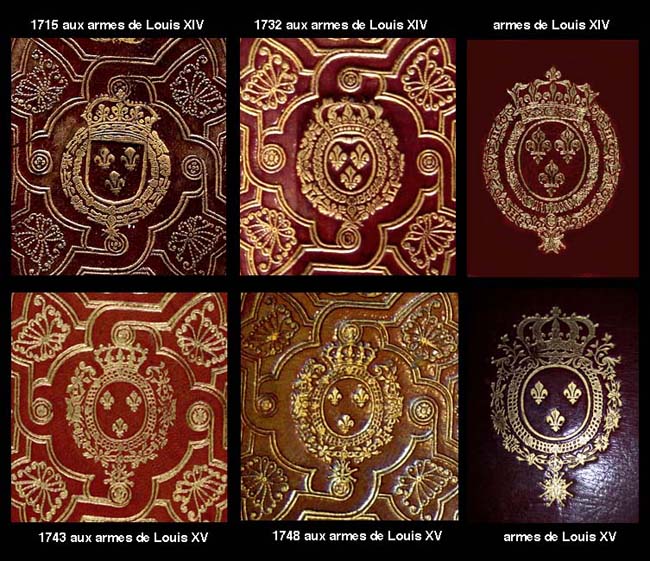
|
From the notes above we learn that Dubuisson succeeded Padeloup as royal binder and that his work is mainly known from the period of 1746-1762. My question is whether or not the plaque bindings shown above predate Dubuisson's work. Perhaps they were even the work of Padeloup. This brings me to the next page where we will discover some more plaque bindings, these are even more mysterious and beautiful. They appear to copy the fanfare style of the Atelier des Caumartin bindings while at the same time imitating the pointillé tools of Padeloup! Click on this link to go to the next page: The Padeloup Plaques! |
| information about the author | visit the NEW (2019) VIRTUAL BOOKBINDINGS |